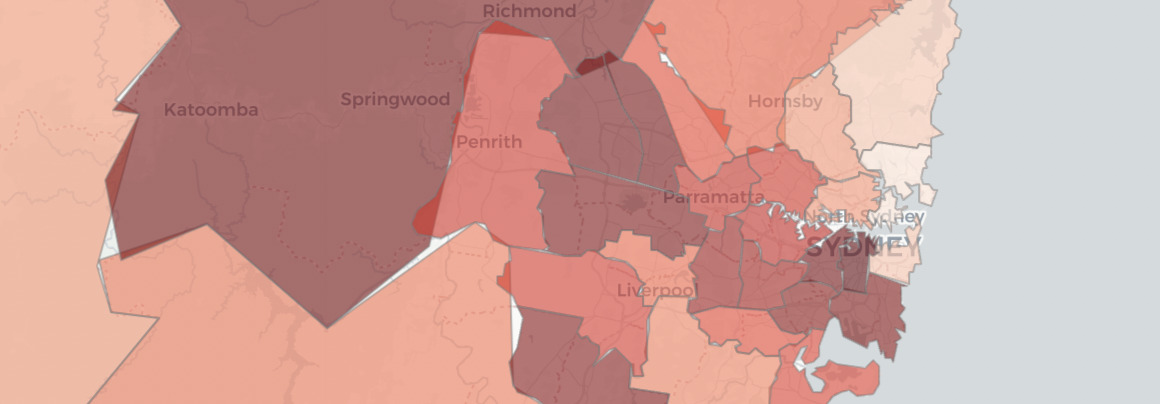There’s a lot to be learned about the trends in this election by looking at how the largest party groupings performed in the two Houses. While the major parties generally polled a lower vote in the Senate than in the House, that pattern varies widely.
In this post, I’ve included a map showing the difference for Labor, Coalition, Greens and One Nation, and you can click through to see the results in both houses for those parties along with the UAP and LDP.
The first thing I noticed in the map is the big drop-offs in the Labor and Greens House votes in seats with strong independents. Indi, Kooyong, Goldstein, Wentworth, Curtin and the northern suburbs of Sydney all show this pattern for both parties.
The combined Labor/Greens Senate vote exceeded 40% in many of these seats, but in Kooyong and North Sydney they exceeded 45%, compared to about 38% in 2019 in those two seats. It suggests a swing to the left which is about more than just the presence of an appealing independent, and suggests the organised parties of the left could have gained big swings in these seats without the presence of independents.
On the other hand, the seats with the biggest increase in the Greens and Labor vote are the three Canberra seats, where David Pocock achieved a similar feat on the Senate ballot as teal independents did on the House ballot. Labor and the Greens polled 45.4% in the Senate in the seat of Canberra, compared to 69.5% in the House.
If you look at the difference for Labor alone, a few other seats pop up. Labor’s House primary vote in Sydney was 13.4% higher than their Senate vote, with Grayndler not far behind. The list of seats with big differences is dominated by NSW seats, with Chifley, Greenway, Macquarie, Eden-Monaro, McMahon, Kingsford Smith, Macarthur and Barton having differences of over 10%. Kingston and Oxley are the only non-NSW seats on this list (apart from the ACT seats mentioned before).
Most of the seats with the biggest Labor gaps in favour of the Senate had a strong independent. Indeed the 16 seats ranked highest all had prominent independents, with Adam Bandt’s seat of Melbourne ranked 17th. The next seat was Gippsland, where the Coalition House vote was almost 14% higher than in the Senate.
The Greens House vote was just 0.3% lower than in the Senate, and about half the seats had a higher House vote. There are four seats where the House vote was more than 5% above the Senate vote, and these seats are Melbourne and the three ACT seats. Richmond and Griffith are ranked next on the list. The Greens House vote was also higher in Macnamara, Ryan and Brisbane, but not by as much as in Griffith and Richmond.
The Coalition House vote exceeded their Senate vote by the most in Gippsland, Maranoa, Canning, Barker and Forrest. At the other end, the Coalition’s vote was relatively lowest in the House in Fowler, where they polled 30% in the Senate and 17% in the House. Apart from races involving independents, the only seats where the Coalition vote was more than 5% lower in the House than the Senate were Richmond (8.7%), Greenway (8%), Chifley (5.4%) and McMahon (5.3%).
Richmond is particularly interesting. The Liberal Democrats polled 5.7% there. It does appear the Liberal House-Senate vote gap was a bit bigger in places where the Liberal Democrats ran in the lower house, so some of it could be voters getting confused, particularly in a seat like Richmond where the Coalition party is the Nationals, but the seat includes substantial urban areas around Tweed.
As for One Nation and United Australia, they tended to do better in the House than the Senate, but there isn’t as much variety.




Will be interesting to hear from all the strategic voting proponents if the ALP is found to have won the 2PP count in Kooyong and North Sydney, when the AEC goes back and does it….
I think one of the reasons the GRN&ALP did better in the Senate than in the House in the Teal seats, was that the Teal hander-outers had messages like “and ALP or Greens in the Senate!”. This may, or may not have been policy in the Teal admin world, but it was certainly happening in Warringah and usually by mutual agreement between those on the ground. Even Zali said it when handing out.
The Teals mostly ran Open Tickets, which required their voters to put their minds to preferences … “thinking voters” perhaps and more likely to mull over a message about the Senate.
And not only the messaging, but also the sheer force of numbers. For instance, in Warringah, The Greens struggled to find 50 volunteers. Zali had 1,400! This was particularly evident at the PPVCs.
So the “thinking voters” that had to think through an Open ticket in the Reps and mull over their vote in the Senate, would have been persuaded by “force of numbers” of campaign volunteers handing out HTV’s??? A voter can only be given a HTV once – the 3rd, and 4th time they are offered it is rather pointless.
A Teal message that was heard in North Sydney was that the Labor candidate couldn’t win, a voter shouldn’t therefore vote for them – it was all about preferences and these were very complicated. My wife had this said to her.
The tactical voting by Labor and greens voters just shows those who did not want a liberal were quite clever. The teals will do good to remember this..part of their vote base. Which was to. Their left overall
Comments are closed.